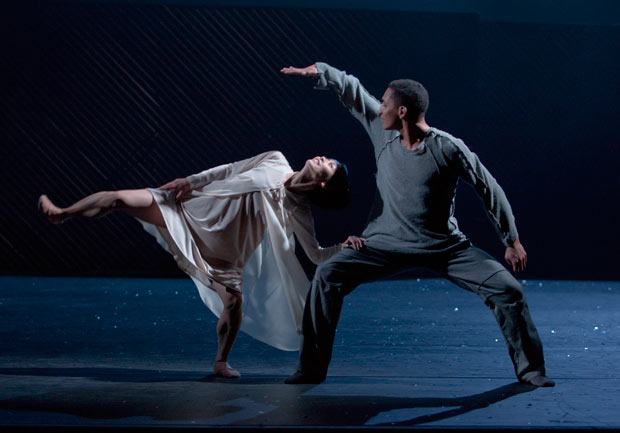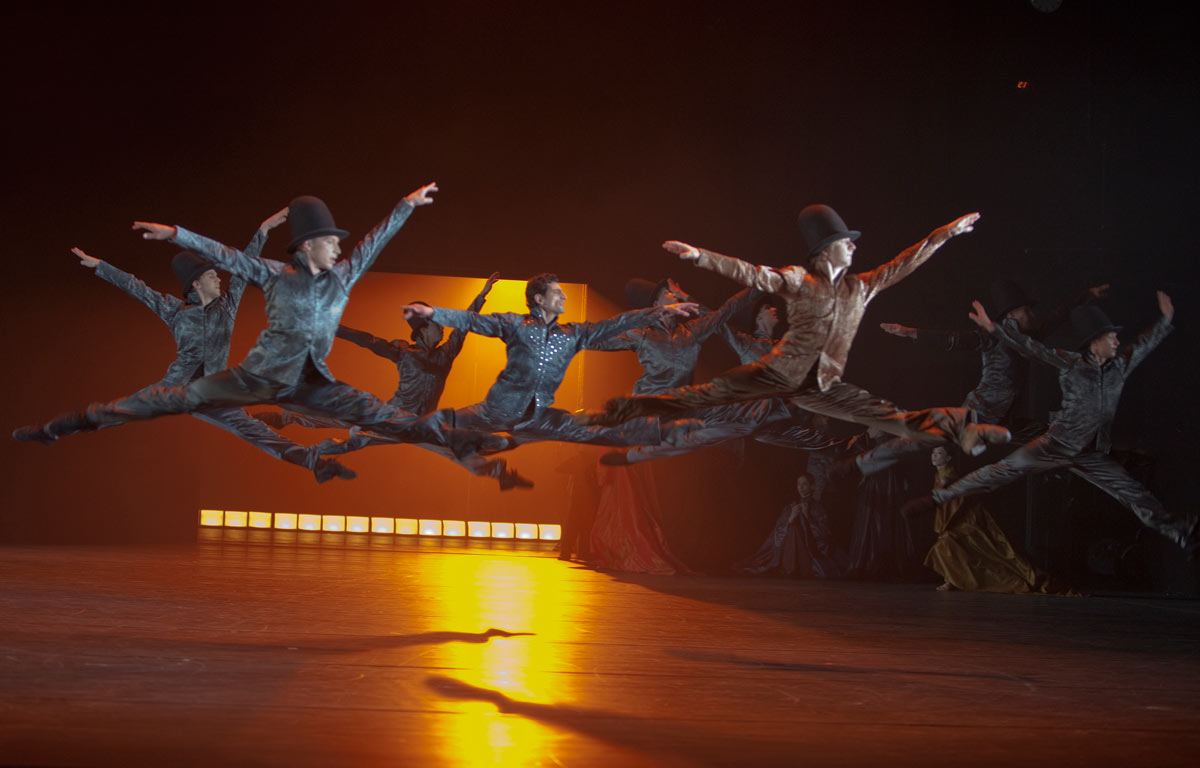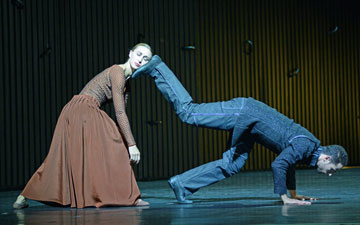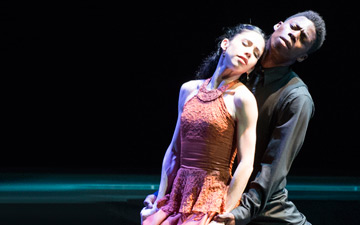
© Gert Weigelt. (Click image for larger version)
Royal Swedish Ballet
Juliet and Romeo
★★★✰✰
Washington, Kennedy Center Opera House
1, 2 June 2016
www.operan.se
www.kennedy-center.org
Mats Ek’s ballet Juliet and Romeo opens with a startling sight: a young man emerges from a dark opening situated in the middle of the stage, quickly climbs over a tall metal wall (or is it a barricade?) that dominates the space, and disappears behind it. The stage is shrouded in darkness and covered with thick smoke. The harsh light from above, dispersed by thick strobes, suggests a no-trespassing-zone. The venue is hardly a sunny Verona.
Choreographer Mats Ek is known for his radical transformation of the traditional ballet repertory. Over the years, he has put his own interpretive stamp on 19th century ballet classics such as Giselle, Swan Lake and Sleeping Beauty. In 2013, Ek, who is widely admired and recognized in his native Sweden, was commissioned to create a new version of Romeo and Juliet to commemorate the Royal Swedish Ballet’s 240th anniversary. In June, the Royal Swedish Ballet traveled to Washington, DC to give Ek’s dance adaptation of Shakespeare’s play its North American premier at the Kennedy Center Opera House.
As the opening scene implies, Ek unfolds Shakespeare’s tale in modern times in an unspecified urban community – a gloomy place where the streets are patrolled by ominous-looking guards riding Segways. The city folks, dressed in nearly identical dark garb – simple dresses for the women, plain jerseys and pants for the men – are always on the go: running, squatting, lunging or collectively moving the metal walls that, over the course of the action, convert the space into a plaza, a balcony, a ballroom and eventually a graveyard. The choreography for the masses feels hectic and hard-edged; yet there are no swordfights here and it’s virtually impossible to distinguish between the two warring clans – the Montagues and Capulets. In fact, the ensemble scenes depicting street unrest are so highly stylized, even sterilized, that the audience gets no sense of violence, imminent danger, or looming tragedy.

© Gert Weigelt. (Click image for larger version)
In this staging, the famous love story, with its devastating finale, has been severely truncated. In his re-imagining of Shakespeare’s classic, Ek opted to forgo Friar Laurence and the secret wedding ceremony, as well as the sleeping potion, the poison and the dagger. Here, Juliet is killed by her own father, in a fit of rage, as punishment for her disobedience and refusal to marry a man she didn’t love; but even her death scene comes across as muted and dramatically impotent. It seems as if she suddenly collapses and expires in the middle of a family quarrel. Romeo’s demise, too, looks startling and inexplicable rather than tragic. This is one of the problems with this provocative, entertaining, but ultimately uneven production: it fails to fully realize its dramatic purpose, rushing through (or entirely omitting) the pivotal moments of the story.
Another problem with Juliet and Romeo is its soundtrack. Ek dispenses with the iconic Prokofiev score to which most traditional productions of the ballet are set; instead, he compiles a collage of Tchaikovsky’s symphonic pieces, including his Piano Concerto No. 1, Suite No. 3, Fifth Symphony, Capriccio Italien and Manfred Symphony. (Interestingly, the choreographer didn’t include any music from Tchaikovsky’s overture-fantasy Romeo and Juliet.) This musical mishmash lacks the dramatic power of the Prokofiev music and only rarely provides an effective counterpoint to the action onstage.
The production nevertheless intrigues the eye and is fueled by the exceptional dancing of the company’s talented and dedicated dancers. During the company’s five-performance run, I saw the performances of both casts.
On opening night, the towering Jérôme Marchand, danced Mercutio and single-handedly pocketed every scene he was in. Bold, muscular, and covered with tattoos, he was a pure force of rowdiness and hilarious mischief. This was a truly plum role and Marchand ran away with it. But some of his scenes felt so over-extended that one could think that Mercutio was the centre of proceedings. His brief death scene, however, looked like an unfortunate accident and felt anticlimactic. Dressed in a puffy jacket and holding his shoulders slouched as if in perpetual apology, Hokuto Kodama brought out the placid and gentle side of Benvolio, the exact opposite of Mercutio’s untamed and profane nature.

© Gert Weigelt. (Click image for larger version)
Mixing child-like shyness with willfulness and passion, Mariko Kida delivered a convincing portrayal of Juliet; her love for Anthony Lomuljo’s Romeo felt palpable and real. The unassuming Lomuljo, however, was too bland and emotionally frozen to leave a memorable impression as a young man deeply in love. An exciting blend of playfulness, awkwardness and abandon, the key duets (in the balcony and the bedroom scenes) were performed with verve and skill by the leads, but the mutual chemistry just wasn’t there and the emotional effect of their dancing felt rather flat.
Ana Laguna made a terrific turn as Juliet’s wise, tender and fun-loving nurse; Arsen Mehrabyan gave a chilling account of Juliet’s violent and despotic father; and Nadja Sellrup was superb as his scheming, cheating wife.
On the following night, Ema Yuasa and Anton Valdbauer as title characters gave an inspiring performance, full of passionate abandon and aching intimacy. Yuasa delivered the role of Juliet with a fantastic sense of theatre, undergoing a believable and poignant transformation from an innocent child to a woman in love to a spirited and unwavering rebel. The charismatic Valdbauer was rapt and earnest in his portrayal of Romeo. Their growing affection visibly reverberated through their bodies and their dancing, acquired the all-consuming, burning urgency that the love between Romeo and Juliet is all about. The rest of the cast was excellent, too, with particular distinction going to Andrey Leonovitch for his heart-stopping rendition of Juliet’s tyrannical father and to Clyde Emmanuel Archer for his vividly touching turn as Mercutio.

















You must be logged in to post a comment.